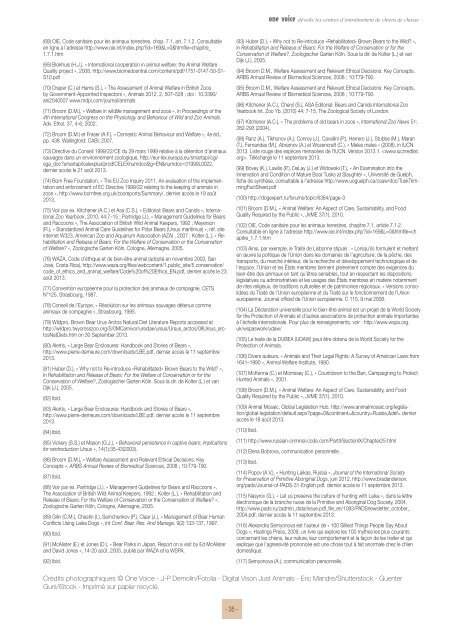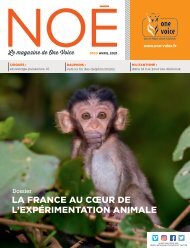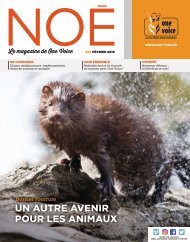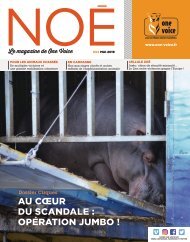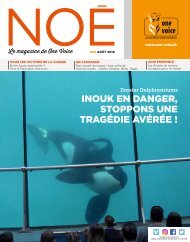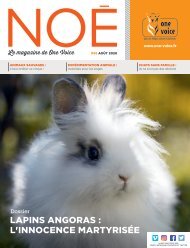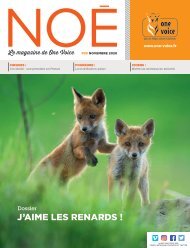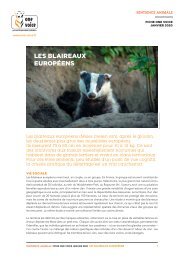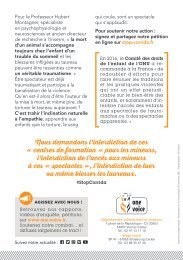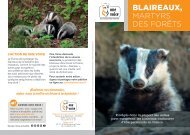Rapport Ours Russie
Create successful ePaper yourself
Turn your PDF publications into a flip-book with our unique Google optimized e-Paper software.
dévoile les centres d’entraînement de chiens de chasse<br />
(68) OIE, Code sanitaire pour les animaux terrestres, chap. 7.1, art. 7.1.2. Consultable<br />
en ligne à l’adresse http://www.oie.int/index.php?id=169&L=0&htmfile=chapitre_<br />
1.7.1.htm<br />
(69) Blokhuis (H.J.), « International cooperation in animal welfare: the Animal Welfare<br />
Quality project », 2008, http://www.biomedcentral.com/content/pdf/1751-0147-50-S1-<br />
S10.pdf<br />
(70) Draper (C.) et Harris (S.), « The Assessment of Animal Welfare in British Zoos<br />
by Government-Appointed Inspectors », Animals 2012, 2, 507–528 ; doi : 10.3390/<br />
ani2040507 www.mdpi.com/journal/animals<br />
(71) Broom (D.M.), « Welfare in wildlife management and zoos », in Proceedings of the<br />
4th International Congress on the Physiology and Behaviour of Wild and Zoo Animals.<br />
Adv. Ethol. 37, 4-6, 2002.<br />
(72) Broom (D.M.) et Fraser (A.F.), « Domestic Animal Behaviour and Welfare », 4e éd.,<br />
pp. 438. Wallingford: CABI, 2007.<br />
(73) Directive du Conseil 1999/22/CE du 29 mars 1999 relative à la détention d’animaux<br />
sauvages dans un environnement zoologique, http://eur-lex.europa.eu/smartapi/cgi/<br />
sga_doc?smartapi!celexplus!prod!CELEXnumdoc&lg=EN&numdoc=31999L0022,<br />
dernier accès le 21 août 2013.<br />
(74) Born Free Foundation, « The EU Zoo Inquiry 2011, An evaluation of the implementation<br />
and enforcement of EC Directive 1999/22 relating to the keeping of animals in<br />
zoos », http://www.bornfree.org.uk/zooreports/Summary/, dernier accès le 19 août<br />
2013.<br />
(75) Voir par ex. Kitchener (A.C.) et Asa (C.S.), « Editorial: Bears and Canids », International<br />
Zoo Yearbook, 2010, 44:7–15 ; Partridge (J.), « Management Guidelines for Bears<br />
and Raccoons », The Association of British Wild Animal Keepers, 1992 ; Meyerson<br />
(R.), « Standardized Animal Care Guidelines for Polar Bears (Ursus maritimus) », réf. site<br />
internet W323, American Zoo and Aquarium Association (AZA) , 2007 ; Kolter (L.), « Rehabilitation<br />
and Release of Bears: For the Welfare of Conservation or the Conservation<br />
of Welfare? », Zoologische Garten Köln, Cologne, Allemagne, 2005.<br />
(76) WAZA, Code d’éthique et de bien-être animal (adopté en novembre 2003, San<br />
José, Costa Rica), http://www.waza.org/files/webcontent/1.public_site/5.conservation/<br />
code_of_ethics_and_animal_welfare/Code%20of%20Ethics_EN.pdf, dernier accès le 23<br />
août 2013.<br />
(77) Convention européenne pour la protection des animaux de compagnie, CETS<br />
N°125, Strasbourg, 1987.<br />
(78) Conseil de l’Europe, « Résolution sur les animaux sauvages détenus comme<br />
animaux de compagnie », Strasbourg, 1995.<br />
(79) Wildpro, Brown Bear Urus Arctos Natural Diet Literature Reports accessed at<br />
http://wildpro.twycrosszoo.org/S/0MCarnivor/ursidae/ursus/Ursus_arctos/08Ursus_arctosNatDiets.htm<br />
on 30 September 2013.<br />
(80) Alertis, « Large Bear Enclosures: Handbook and Stories of Bears »,<br />
http://www.pierre-demeure.com/downloads/LBE.pdf, dernier accès le 11 septembre<br />
2013.<br />
(81) Huber (D.), « Why not to Re-introduce «Rehabilitated» Brown Bears to the Wild? »,<br />
in Rehabilitation and Release of Bears: For the Welfare of Conservation or for the<br />
Conservation of Welfare?, Zoologischer Garten Köln. Sous la dir. de Kolter (L.) et van<br />
Dijk (J.), 2005.<br />
(82) Ibid.<br />
(83) Alertis, « Large Bear Enclosures: Handbook and Stories of Bears »,<br />
http://www.pierre-demeure.com/downloads/LBE.pdf, dernier accès le 11 septembre<br />
2013.<br />
(84) Ibid.<br />
(85) Vickery (S.S.) et Mason (G.J.), « Behavioral persistence in captive bears: implications<br />
for reintroduction Ursus », 14(1):35-43(2003).<br />
(86) Broom (D.M.), « Welfare Assessment and Relevant Ethical Decisions: Key<br />
Concepts », ARBS Annual Review of Biomedical Sciences, 2008 ; 10:T79-T90.<br />
(87) Ibid.<br />
(88) Voir par ex. Partridge (J.), « Management Guidelines for Bears and Raccoons »,<br />
The Association of British Wild Animal Keepers, 1992 ; Kolter (L.), « Rehabilitation and<br />
Release of Bears: For the Welfare of Conservation or the Conservation of Welfare? »,<br />
Zoologische Garten Köln, Cologne, Allemagne, 2005.<br />
(89) Gilin (C.M.), Chestin (I.), Semchenkov (P.), Claar (J.), « Management of Bear Human<br />
Conflicts Using Laika Dogs », Int Conf. Bear. Res. And Manage. 9(2):133-137, 1997.<br />
(90) Ibid.<br />
(91) McAlister (E.) et Jones (D.), « Bear Parks in Japan, Report on a visit by Ed McAlister<br />
and David Jones », 14-20 août, 2005, publié par WAZA et la WSPA.<br />
(92) Ibid.<br />
(93) Huber (D.), « Why not to Re-introduce «Rehabilitated» Brown Bears to the Wild? »,<br />
in Rehabilitation and Release of Bears: For the Welfare of Conservation or for the<br />
Conservation of Welfare?, Zoologischer Garten Köln. Sous la dir. de Kolter (L.) et van<br />
Dijk (J.), 2005.<br />
(94) Broom D.M., Welfare Assessment and Relevant Ethical Decisions: Key Concepts,<br />
ARBS Annual Review of Biomedical Sciences, 2008 ; 10:T79-T90.<br />
(95) Broom D.M., Welfare Assessment and Relevant Ethical Decisions: Key Concepts,<br />
ARBS Annual Review of Biomedical Sciences, 2008 ; 10:T79-T90.<br />
(96) Kitchener (A.C.), Cheryl (S.), ASA Editorial: Bears and Canids International Zoo<br />
Yearbook Int. Zoo Yb. (2010) 44: 7-15, The Zoological Society of London.<br />
(97) Kitchener (A.C.), « The problems of old bears in zoos », International Zoo News 51:<br />
282-293 (2004).<br />
(98) Ranz (A.), Tikhonov (A.), Conroy (J.), Cavallini (P.), Herrero (J.), Stubbe (M.), Maran<br />
(T.), Fernandes (M.), Abramov (A.) et Wozencraft (C.), « Meles meles » (2008), in IUCN<br />
2013. Liste rouge des espèces menacées de l’IUCN. Version 2013.1. . Téléchargé le 11 septembre 2013.<br />
(99) Bovey (K.), Lawlis (P.), DeLay (J.) et Widowski (T.), « An Examination into the<br />
Innervation and Condition of Mature Boar Tusks at Slaughter », Université de Guelph,<br />
fiche de synthèse, consultable à l’adresse http://www.uoguelph.ca/csaw/doc/TuskTrimmingFactSheet.pdf<br />
(100) http://dogexpert.ru/forums/topic/6384/page-3<br />
(101) Broom (D.M.), « Animal Welfare: An Aspect of Care, Sustainability, and Food<br />
Quality Required by the Public », JVME 37(1), 2010.<br />
(102) OIE, Code sanitaire pour les animaux terrestres, chapitre 7.1, article 7.1.2.<br />
Consultable en ligne à l’adresse http://www.oie.int/index.php?id=169&L=0&htmfile=ch<br />
apitre_1.7.1.htm<br />
(103) Ainsi, par exemple, le Traité de Lisbonne stipule : « Lorsqu’ils formulent et mettent<br />
en œuvre la politique de l’Union dans les domaines de l’agriculture, de la pêche, des<br />
transports, du marché intérieur, de la recherche et développement technologique et de<br />
l’espace, l’Union et les États membres tiennent pleinement compte des exigences du<br />
bien-être des animaux en tant qu’êtres sensibles, tout en respectant les dispositions<br />
législatives ou administratives et les usages des États membres en matière notamment<br />
de rites religieux, de traditions culturelles et de patrimoines régionaux. » Versions consolidées<br />
du Traité de l’Union européenne et du Traité sur le fonctionnement de l’Union<br />
européenne. Journal officiel de l’Union européenne, C 115, 9 mai 2008.<br />
(104) La Déclaration universelle pour le bien-être animal est un projet de la World Society<br />
for the Protection of Animals et d’autres associations de protection animale importantes<br />
à l’échelle internationale. Pour plus de renseignements, voir : http://www.wspa.org.<br />
uk/wspaswork/udaw/<br />
(105) Le texte de la DUBEA (UDAW) peut être obtenu de la World Society for the<br />
Protection of Animals.<br />
(106) Divers auteurs, « Animals and Their Legal Rights: A Survey of American Laws from<br />
1641–1990 », Animal Welfare Institute, 1990.<br />
(107) McKenna (C.) et Morrissey (C.), « Countdown to the Ban, Campaigning to Protect<br />
Hunted Animals », 2001.<br />
(108) Broom (D.M.), « Animal Welfare: An Aspect of Care, Sustainability, and Food<br />
Quality Required by the Public », JVME 37(1), 2010.<br />
(109) Animal Mosaic, Global Legislation Hub, http://www.animalmosaic.org/legislation/global-legislation/default.aspx?page=0&continent=&country=Russia,&def=<br />
dernier<br />
accès le 18 août 2013.<br />
(110) Ibid.<br />
(111) http://www.russian-criminal-code.com/PartII/SectionIX/Chapter25.html<br />
(112) Elena Bobrova, communication personnelle.<br />
(113) Ibid.<br />
(114) Popov (A.V.), « Hunting Laikas, Russia », Journal of the International Society<br />
for Preservation of Primitive Aboriginal Dogs, juin 2012, http://www.bradanderson.<br />
org/pads/Journal-of-PADS-31-English.pdf, dernier accès le 11 septembre 2013.<br />
(115) Nasyrov (G.), « Let us preserve the culture of hunting with Laika », dans la lettre<br />
électronique de la branche russe de la Primitive and Aboriginal Dog Society, 2004,<br />
http://www.pads.ru/zadmin_data/issue.pdf_file_en/1083/PADSnewsletter_october_<br />
2004.pdf, dernier accès le 11 septembre 2013.<br />
(116) Alexandra Semyonova est l’auteur de « 100 Silliest Things People Say About<br />
Dogs », Hastings Press, 2009, un livre qui explore les 100 mythes les plus courants<br />
concernant les chiens, leur nature, leur comportement et la façon de les traiter et qui<br />
explique que l’agressivité prononcée est une chose tout à fait anormale chez le chien<br />
domestique.<br />
(117) Semyonova (A.), communication personnelle.<br />
Crédits photographiques © One Voice - J-P Demolin/Fotolia - Digital Vison Just Animals - Eric Mandre/Shutterstock - Guenter<br />
Guni/iStock - Imprimé sur papier recyclé.<br />
- 35 -


